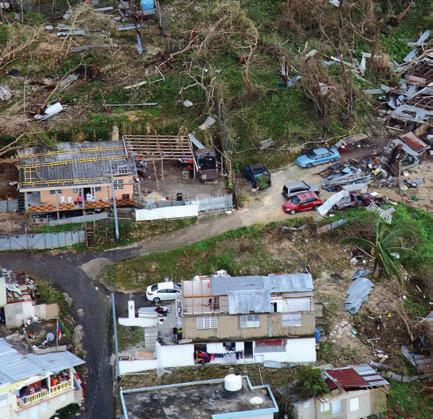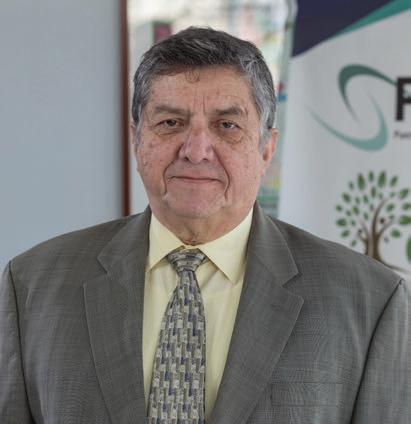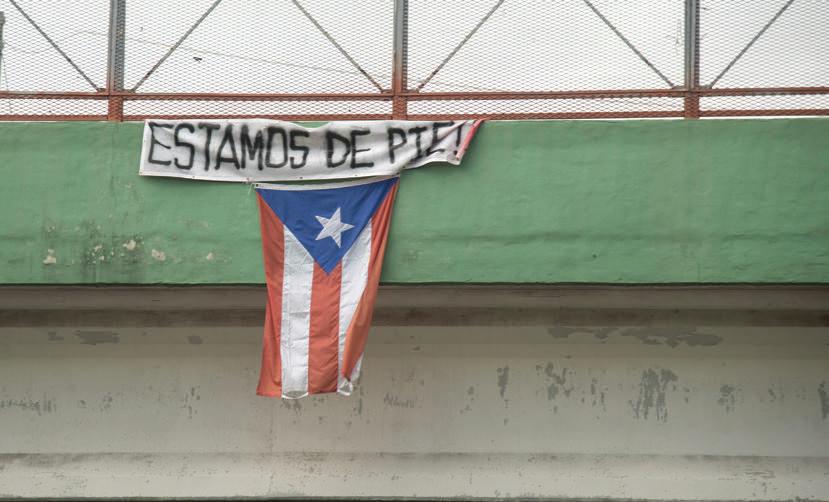
4 minute read
Beyond Belief
Rebuilding and preparing Puerto Rico for the next storm
José Cordero had seen the news reports.
When the lingering bands of Hurricane Maria finally gave way to blue skies, the enormity of the storm’s impact on the island of Puerto Rico was laid bare.
Beginning in the southeast corner of the island, the storm had slowly crawled across the land, dumping unprecedented amounts of rain and battering homes with 155 mile per hour sustained winds.
Puerto Rico was devastated.
As soon as the first non-emergency flights could return to the island, Cordero, Patel Distinguished Professor of Public Health and head of the department of epidemiology and biostatistics, was on one.
A leading epidemiologist in the area of prenatal health, his research for the past decade had been dedicated to improving the health of mothers and babies in Puerto Rico.
But Cordero was not only returning to a research site. He was returning home.

Photos by US Department of Defense, 2017.
Born and raised in Puerto Rico, Cordero left home to further his training in the burgeoning field of prenatal genetic testing. Eventually, Cordero transitioned his work into epidemiology, dedicating his career to identifying the factors that can lead to preterm births, birth defects and infant deaths.
In 2005, Cordero was asked to return home to help Puerto Rican health officials figure out what could be behind an unprecedented spike in preterm births. Between 1990 and 2007, Puerto Rico experienced a doubling in preterm birth rates, and no one knew why.
“To me, it was an eye opener,” said Cordero. “It became evident that the usual suspects like access to healthcare, maternal education, none of those explained why we had such an increase in preterm births in Puerto Rico.”
He very quickly learned that Puerto Rico had more EPA-recognized toxic waste sites per square mile than any other jurisdiction in the U.S. The University of Puerto Rico, in partnership with Northeastern University, put together plan to look at environmental toxins and pregnancy.
Cordero currently co-directs the Puerto Rico Test site for Exploring Contamination Threats (PROTECT) Center as well as the Center for Research on Early Childhood Exposure and Development (CRECE), both of which examine how exposure to environmental contaminants contributes to the high rate of preterm birth.
He regularly flies back and forth between Puerto Rico and Athens to care for patients and collect data, so he was eager to get to Manati, on the northern coast, to learn how his patients and staff fared.
He wasn’t prepared for the scene he would find, peering down over a once familiar landscape, that now seemed alien.
“It was beyond belief. It was like a giant mower had come through and taken all the leaves,” said Cordero. “There were some trees standing, many fallen, but they were just like toothpicks that had been blown away.”
The plane passed over homes, roofs missing. “We could see into their homes, and it was like that until we arrived at the airport,” remembered Cordero.
Maria was the third major hurricane to hit U.S. territory in the 2017 season and the most intense. In the weeks that followed, the U.S. government and emergency aid groups were on hand to help Puerto Rico begin rebuilding.
Cordero was there, too.

Dr. José Cordero
Photo by Gabriel González, 2017.
Like most islanders, the staff working at his research clinics in Manati were heavily impacted by the storm. Nearly half had no running water, and several had to go source water from the local river.
“That was a reason that we immediately began requesting and received water filters. We trained our staff on how to use them and had them distribute filters to their communities,” said Cordero. “That was our first involvement.”
Expanding his sight to the local community health clinics, Cordero leveraged his connections with groups in the U.S. to ship in much needed medications and other supplies such as intravenous fluids and insulin.
“It was sort of like group-to-group direct aid instead of going through all the convoluted process of FEMA that really was very deficient,” he said.
QUICKLY, HIS ROLE IN PUERTO RICO PUBLIC HEALTH SHIFTED TO INCLUDE DISASTER PREPAREDNESS
It took two weeks for Cordero’s own clinic to regain power. In that time, many participants came to the clinics looking for supplies like baby diapers and for information. It was moving, says Cordero, to see how much the community relied on the clinic for help.
The PROTECT Center has cultivated a culture of trust with the community. They’d rejected the traditional biomedical approach of collecting samples and information from patients without any commitment to report findings back to participants.
From the outset, the project was designed to be community-based, participatory research. Cordero wants the families in Manati to learn as much from his work as he does.
Cordero feels his team’s work had a positive effect.
In the months that followed Maria, Cordero’s team was recruited by Medtronic, a pharmaceutical devices company and the largest private sector employer in Puerto Rico, to conduct a needs assessment in the five municipalities where the company operates.
“That’s something our community engagement group is very experienced in doing, and we’re doing that as we speak,” said Cordero. “What we expect is we’ll have an opportunity to identify areas where Medtronic and our program can collaborate in improving community resilience because hurricanes are going to continue to come.”
Today, Cordero is working with local private and government entities to better prepare the island for the next big storm. He is also supporting the development of an institute of public health, aimed at supporting the island’s public health department in their work.
“The health department infrastructure is very poor,” he said, “and the primary lab lost their roof, so they had to stop operations.”
For almost ten months, all the public health testing from leptospirosis to dengue was sent to the CDC, said Cordero.
In 2019, Puerto Rico’s infrastructure continues to recover. And new sectors are joining in the effort to build a more robust healthcare system, including private companies like Verizon Wireless.
Cordero says he is glad to see that the effort to avoid the catastrophe of Maria and protect the health and safety of Puerto Ricans is being shared across multiple sectors.
As the promise of stronger and more destructive storms threaten the Caribbean and eastern U.S., Cordero sees the role of public health as crucial.
Representing the college at a recent National Academies of Sciences, Engineering, and Medicine meeting on data collection following large-scale weather disasters, Cordero said that understanding the specific impacts of disasters can shape policy and save lives.
But we should never lose sight of the reason behind the work. “The data – the dots on a map –remember, those are people,” he said.

Photos by US Department of Defense, 2017.










